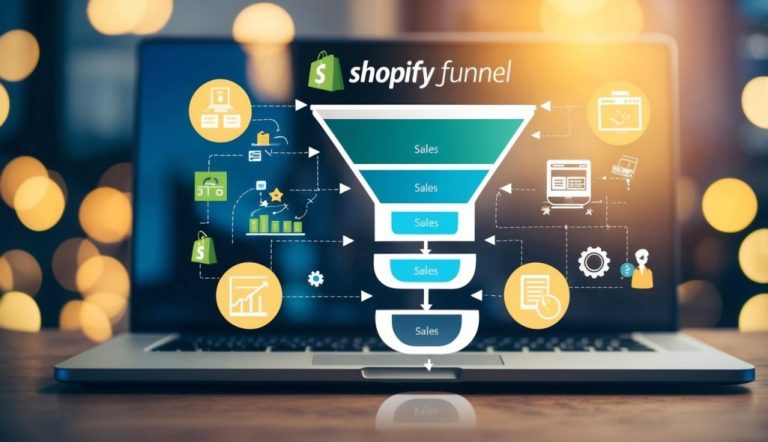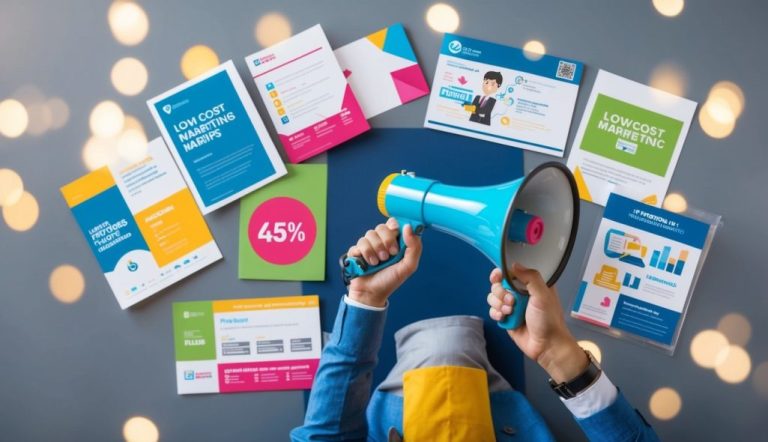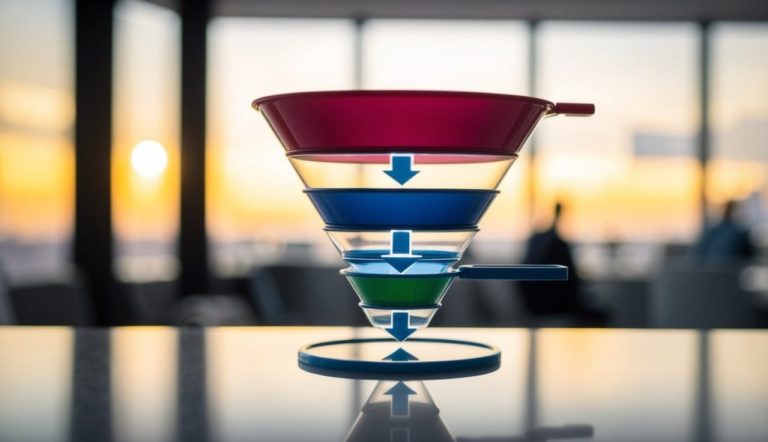A B2B sales funnel is a crucial tool for transforming potential leads into loyal customers. It’s a structured path that guides buyers through different stages, from awareness to making a purchase. Understanding these stages can help you unlock the potential of your sales process and boost conversions.
This article will explore real-world examples to help you visualize and create effective B2B sales funnels for your business.

You’ll learn how companies successfully use strategies to engage prospects early on and nurture them until they are ready to buy. From leveraging social media to utilizing email campaigns, these examples will provide insights into what works best at each stage of the funnel. By applying these tactics, you can enhance your sales activities and drive better results.
Key Takeaways
- Learn how to create effective B2B sales funnels.
- Discover strategies for nurturing and converting leads.
- Optimize your funnel for maximum results.
Understanding B2B Sales Funnels
B2B sales funnels guide businesses in transforming potential leads into customers by mapping every step of the customer journey. You’ll explore different components and stages that structure a B2B sales funnel, highlighting how they differ from B2C sales funnels.
Components of a B2B Sales Funnel
A B2B sales funnel has several key components that help manage the customer journey. It usually starts by defining your target audience to craft tailored strategies. Then comes the creation of content tailored for different stages, which keeps potential customers engaged.
Metrics are essential to track progress and adapt strategies. These may include conversion rates and engagement levels. Finally, feedback loops allow you to refine processes continuously, based on successful and unsuccessful outcomes.
Stages of a B2B Sales Funnel
The B2B sales funnel includes several essential stages. The awareness stage is where potential customers first learn about your business, often through marketing efforts like ads and content. Next comes the interest stage, where you engage customers with relevant and informative content.
In the evaluation stage, potential leads compare different options before making decisions. Decision-making and closing the deal occur in the consideration and purchase stages. Your job is to nurture these leads effectively throughout each stage.
B2B Sales Funnel vs. B2C Sales Funnel
B2B and B2C sales funnels differ in complexity and length. The B2B sales cycle is usually longer and more complex, involving multiple decision-makers and higher-value transactions. This requires more thorough lead nurturing and trust-building, often using personalized approaches.
In B2B, stages are tailored to accommodate detailed evaluations and considerations, whereas B2C funnels might focus more on quick decisions and emotional appeals. Understanding these differences helps in aligning strategies with the expectations of B2B buyers, ensuring a smoother journey through the funnel.
For further reading on B2B sales funnel dynamics, check out some detailed examples.
Creating Effective B2B Sales Funnels
To create effective B2B sales funnels, focus on aligning your content with customer needs, enhancing online visibility, and engaging prospects through strategic marketing efforts. The upcoming sections detail how to define your audience, use educational content, achieve high search engine rankings, and leverage digital marketing tools efficiently.
Identifying Your Ideal Customer Profile
Start by clearly defining your ideal customer profile. This step helps you focus your efforts on potential leads who are most likely to benefit from your products or services. Consider factors like industry, company size, budget, and decision-making processes.
Creating detailed buyer personas can aid in understanding customer needs and preferences. An accurate profile will guide your lead generation strategies and ensure effective targeting throughout your sales funnel. It allows your marketing teams to tailor their messages and identify the most promising leads in your sales pipeline.
Developing Educational Content
Educational content is crucial in guiding prospects through the sales process. Focus on creating valuable resources that address specific challenges faced by your target audience. This includes blogs, whitepapers, and case studies that provide insights into your solutions.
By offering helpful content, you establish authority in your industry while nurturing leads. An informed prospect is more likely to proceed to later stages of the funnel. This approach supports lead nurturing by ensuring you maintain constant communication with potential clients as they consider your offerings.
Utilizing SEO and Inbound Marketing
Implement SEO to increase the visibility of your educational content. Use keywords related to your industry to improve search engine rankings. This increases the likelihood of attracting relevant traffic to your site, creating more opportunities for lead generation.
Inbound marketing is about drawing prospects in by making it easy for them to find solutions through your content. Techniques such as optimizing your website structure and producing engaging blog posts help in reducing costs associated with traditional marketing.
Leveraging Email Marketing Campaigns and Webinars
Email marketing campaigns and webinars are powerful tools for engaging leads. These methods offer ways to deliver personalized follow-ups and maintain interest in your offerings. Use targeted email sequences to guide potential customers through your sales funnel.
Webinars provide an interactive platform to showcase your expertise and address customer needs directly. By offering in-depth knowledge and solutions, you reinforce your brand’s credibility. Both strategies can play vital roles in moving leads closer to making a purchase decision.
Converting Leads into Customers
Converting leads into customers involves several crucial steps. It requires effective lead nurturing, strategic meetings with decision-makers, and efficient management of the sales pipeline. Utilizing case studies and testimonials can also play a significant role in the final decision-making process.
The Importance of Lead Nurturing
Nurturing leads is key to keeping potential customers engaged. It’s about building relationships by sharing relevant content and insights at the right time. Your sales team should focus on addressing specific pain points and demonstrating how your product can solve these issues.
Use analytics to track engagement and refine your approach. This ensures leads move smoothly through the interest stage, increasing the chances of them becoming Sales Qualified Leads (SQLs).
Reaching Decision-Makers Through Meetings and Discovery Calls
Connecting with decision-makers requires strategic planning. Discovery calls offer a chance to understand their needs and tailor your product demos to those requirements. Meanwhile, meetings are an opportunity to present your solutions and address any objections.
Focus on personalization during these interactions. This builds trust, making decision-makers more likely to consider your offerings seriously. Ensure your team is prepared with negotiation strategies to close the deal effectively.
Effectively Managing the Sales Pipeline
Managing your sales pipeline efficiently is crucial for conversion. Monitor the pipeline to identify bottlenecks and adjust your strategies accordingly. Ensure that lead qualification is thorough, allowing the sales team to focus on high-potential opportunities.
Regularly update your pipeline to keep track of where each lead stands in the process. This helps in prioritizing tasks and recognizing when it’s time to push for closing the sale.
Case Studies and Testimonials in the Decision Stage
Case studies and testimonials are powerful tools in the decision stage. They provide real-world examples of how your product has benefited others, enhancing credibility. Sharing these success stories can influence potential customers by illustrating proof of value.
Make sure to include specific results or outcomes to highlight remarkable achievements. This not only reassures prospects but also strengthens your position during negotiations and aids in boosting customer retention.
Optimizing Your B2B Sales Funnel
Optimizing your B2B sales funnel requires focusing on analytics, aligning sales and marketing, scoring leads, and regularly testing strategies. These elements help tailor your sales approach, enhance customer retention, and boost conversions.
Role of Analytics in Sales Funnel Optimization
Analytics play a crucial role in refining your B2B sales funnel. By monitoring metrics at each stage, you can understand the customer journey more deeply. Track conversion rates, identify drop-off points, and make informed adjustments to improve sales pipelines.
Analytics tools allow you to measure the effectiveness of lead nurturing strategies and understand how potential customers interact with your content. Consistently analyzing data results in a more efficient and effective funnel, maximizing your marketing efforts.
Sales and Marketing Alignment
Aligning sales and marketing teams ensures a unified approach to reaching your ideal customer profile. Regular communication between teams leads to shared objectives and messaging, which helps engage potential customers effectively.
This alignment facilitates a seamless transition through the awareness, interest, and decision stages. Collaborate on campaigns, share insights, and jointly develop strategies for better customer engagement. This collaboration is vital for effective sales pipelines, preventing any disconnect in your funnel’s approach to attracting and securing leads.
Lead Scoring and Qualification
Lead scoring and qualification determine how sales-ready a prospect is, optimizing the sales funnel for service or product-based businesses. Use criteria like engagement level, company size, and authority within the company to rank leads.
High scores indicate potential leads that match your ideal customer profile. This process allows sales teams to focus on qualified prospects, improving conversion rates and reducing the time spent on less promising leads. Lead scoring also aids in tailoring communication to specific customer needs, enhancing the chance of moving them through the funnel efficiently.
Continuous Improvement and A/B Testing
Adopt continuous improvement methods and A/B testing to keep your sales strategies effective. Regularly test different approaches, such as email content and landing page designs, to see which yields the best results.
A/B testing can provide valuable insights into what resonates with your audience. This ongoing process enables you to refine lead generation efforts continually. Continuous improvement ensures that each stage of the sales funnel is working optimally, adapting to changes in market trends or customer preferences, and ultimately increasing customer retention and engagement.
Frequently Asked Questions
Understanding the B2B sales funnel is crucial for improving business strategies. It involves knowing its components, the differences from B2C funnels, and the stages involved. Let’s explore these aspects through common questions.
What are the key components of an effective B2B sales funnel?
An effective B2B sales funnel includes awareness, interest, decision, and action stages. Each stage involves tactics like lead generation, nurturing, and closing sales. Attention to customer needs and pain points is essential.
How does a B2B sales funnel differ from a B2C sales funnel?
A B2B sales funnel often involves a longer sales cycle and multiple decision-makers. It focuses more on relationship building and trust. In contrast, B2C funnels target individual consumers with quicker purchase decisions.
Can you outline the stages of a B2B sales pipeline and their functions?
The stages typically include awareness, consideration, intent, evaluation, and purchase. Awareness is about attracting potential clients. Consideration involves providing information, while intent and evaluation focus on demonstrating product value. The purchase stage closes the deal.
What strategies enhance the conversion rates at different stages of the B2B sales funnel?
Personalized content and targeted outreach improve conversions. Offering demos and consultations can move leads through the funnel. Building trust through testimonials and case studies also helps.
How do small businesses tailor B2B sales funnel examples to their specific needs?
Small businesses can adapt funnels by focusing on niche markets and personalized service. Using cost-effective strategies like digital marketing and networking can create a strong lead nurturing process.
What role does content marketing play in a B2B marketing funnel?
Content marketing helps educate and engage potential clients. It addresses their pain points and positions your business as a solution provider. Formats like blogs, webinars, and case studies are effective ways to drive engagement.





